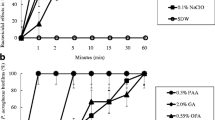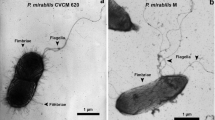Abstract
Biofilm in endoscopes is a major problem that can result in failure of disinfection. We studied the survival of K. pneumoniae in a biofilm formed on endoscope tubes subjected to combined chemical and physical stresses. We monitored bacterial survival in the biofilm after the action of 1% and 2% GTA either immediately or after 15 days of desiccation and described the ability of surviving bacteria to recolonize endoscope tubing in a dynamic model. There were surviving bacteria after 5-min exposure to 2% and 1% GTA. The percentage of survivors after 2% and 1% GTA was greater when the GTA treatment was performed after 15 days of prior desiccation of the biofilm. The survivors were able to recolonize and reform biofilm on abiotic surfaces probably because of the survival of persisters in a viable but non-culturable state in the biofilm. Our findings emphasize that the current guidelines on endoscope reprocessing should be strictly followed but that once constituted the biofilm in endoscope tubing will be very difficult to eradicate with present practices.




Similar content being viewed by others
References
Costerton JW, Lewandowski Z, Caldwell DE, Korber DR, Lappin-Scott HM (1995) Microbial biofilms. Annu Rev Microbiol 49:711–745
Donlan RM, Costerton JW (2002) Biofilms: survival mechanisms of clinically relevant microorganisms. Clin Microbiol Rev 15:167–193
Lewis K (2010) Persister cells. Annu Rev Microbiol 64:357–372
Li L, Mendis N, Trigui H, Oliver JD, Faucher SP (2014) The importance of the viable but non-culturable state in human bacterial pathogens. Front Microbiol 5:258
Høiby N, Bjarnsholt T, Givskov M, Molin S, Ciofu O (2010) Antibiotic resistance of bacterial biofilms. Int J Antimicrob Agents 35(4):322–332
Kovaleva J, Peters FT, van der Mei HC, Degener JE (2013) Transmission of infection by flexible gastrointestinal endoscopy and bronchoscopy. Clin Microbiol Rev 26(2):231–254
Rahman MR, Perisetti A, Coman R, Bansal P, Chhabra R, Goyal H (2019) Duodenoscope-associated infections: update on an emerging problem. Dig Dis Sci 64(6):1409–1418
Hennequin C, Aumeran C, Robin F, Traore O, Forestier C (2012) Antibiotic resistance and plasmid transfer capacity in biofilm formed with a CTX-M-15-producing Klebsiella pneumoniae isolate. J Antimicrob Chemother 67(9):2123–2130
Aumeran C, Poincloux L, Souweine B, Robin F, Laurichesse H, Baud O, Bommelaer G, Traoré O (2010) Multidrug-resistant Klebsiella pneumoniae outbreak after endoscopic retrograde cholangiopancreatography. Endoscopy 42(11):895–899
Pajkos A, Vickery K, Cossart Y (2004) Is biofilm accumulation on endoscope tubing a contributor to the failure of cleaning and decontamination? J Hosp Infect 58(3):224–229
Kovaleva J (2017) Endoscope drying and its pitfalls. J Hosp Infect 97(4):319–328
Vickery K, Pajkos A, Cossart Y (2004) Removal of biofilm from endoscopes: evaluation of detergent efficiency. Am J Infect Control 32(3):170–176
Russell AD (1994) Glutaraldehyde: current status and uses. Infect Control Hosp Epidemiol 15(11):724–733
Beilenhoff U, Biering H, Blum R, Brljak J, Cimbro M, Dumonceau J-M, Hassan C, Jung M, Kampf B, Neumann C, Pietsch M, Pineau L, Ponchon T, Rejchrt S, Rey JF, Schmidt V, Tillett J, van Hooft JE (2018) Reprocessing of flexible endoscopes and endoscopic accessories used in gastrointestinal endoscopy: position statement of the European Society of Gastrointestinal Endoscopy (ESGE) and European Society of Gastroenterology Nurses and Associates (ESGENA) – update 2018. Endoscopy 50(12):1205–1234
Alfa MJ, Howie R (2009) Modeling microbial survival in buildup biofilm for complex medical devices. BMC Infect Dis 9:56
Ofstead CL, Wetzler HP, Heymann OL, Johnson EA, Eiland JE, Shaw MJ (2017) Longitudinal assessment of reprocessing effectiveness for colonoscopes and gastroscopes: results of visual inspections, biochemical markers, and microbial cultures. Am J Infect Control 45(2):26–33
da Costa LC, Olson N, Tipple AF, Alfa M (2016) Evaluation of the ability of different detergents and disinfectants to remove and kill organisms in traditional biofilm. Am J Infect Control 44(11):243–249
Alfa MJ, Ribeiro MM, da Costa LC, Franca R, Olson N, DeGagne P, Singh H (2017) A novel polytetrafluoroethylene-channel model, which simulates low levels of culturable bacteria in buildup biofilm after repeated endoscope reprocessing. Gastrointest Endosc 86(3):442–451
Aumeran C, Thibert E, Chapelle FA, Hennequin C, Lesens O, Traoré O (2012) Assessment on experimental bacterial biofilms and in clinical practice of the efficacy of sampling solutions for microbiological testing of endoscopes. J Clin Microbiol 50(3):938–942
Tolker-Nielsen T, Sternberg C. 2011. Growing and analyzing biofilms in flow chambers. Curr Protoc Microbiol. Chapter 1:unit 1B.2
Stewart PS, Costerton JW (2001) Antibiotic resistance of bacteria in biofilms. Lancet 358(9276):135–138
Tuomanen E, Cozens R, Tosch W, Zak O, Tomasz A (1986) The rate of killing of Escherichia coli by beta-lactam antibiotics is strictly proportional to the rate of bacterial growth. J Gen Microbiol 132(5):1297–1304
Martin DJ, Denyer SP, McDonnell G, Maillard JY (2008) Resistance and cross-resistance to oxidising agents of bacterial isolates from endoscope washer disinfectors. J Hosp Infect 69(4):377–383
Tschudin-Sutter S, Frei R, Kampf G, Tamm M, Pflimlin E, Battegay M, Widmer AF (2011) Emergence of glutaraldehyde-resistant Pseudomonas aeruginosa. Infect Control Hosp Epidemiol 32(12):1173–1178
Ofstead CL, Hopkins KM, Buro BL, Eiland JE, Wetzler HP (2019) Challenges in achieving effective high-level disinfection in endoscope reprocessing. Am J Infect Control S0196-6553(19):30849–30841
Greenwald DA (2015) Endoscopic hang time: can we get some clarity? Gastrointest Endosc 81(5):1155–1157
Perumpail RB, Marya NB, McGinty BL, Muthusamy VR (2019) Endoscope reprocessing: comparison of drying effectiveness and microbial levels with an automated drying and storage cabinet with forced filtered air and a standard storage cabinet. Am J Infect Control 47(9):1083–1089
Ren-Pei W, Hui-Jun X, Ke Q, Dong W, Xing N, Zhao-Shen L (2014) Correlation between the growth of bacterial biofilm in flexible endoscopes and endoscope reprocessing methods. Am J Infect Control 42(11):1203–1206
Vickery K, Ngo Q-D, Zou J, Cossart YE (2009) The effect of multiple cycles of contamination, detergent washing, and disinfection on the development of biofilm in endoscope tubing. Am J Infect Control 37(6):470–475
Acknowledgments
We thank Jeffrey Watts for his help in preparing the manuscript.
Author information
Authors and Affiliations
Corresponding author
Additional information
Publisher’s note
Springer Nature remains neutral with regard to jurisdictional claims in published maps and institutional affiliations.
Electronic supplementary material
ESM 1
(PPT 107 kb)
Rights and permissions
About this article
Cite this article
Cholley, A.C., Traoré, O., Hennequin, C. et al. Klebsiella pneumoniae survival and regrowth in endoscope channel biofilm exposed to glutaraldehyde and desiccation. Eur J Clin Microbiol Infect Dis 39, 1129–1136 (2020). https://doi.org/10.1007/s10096-020-03818-7
Received:
Accepted:
Published:
Issue Date:
DOI: https://doi.org/10.1007/s10096-020-03818-7




